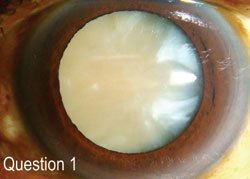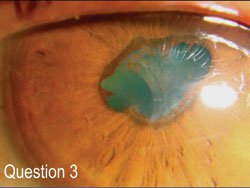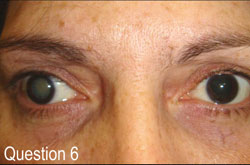Cataract quiz for residents, part 1
Test your knowledge and judgment as you assess risks and predict outcomes in six clinical scenarios.
 Uday Devgan |
Over the course of the past 5 years, we have covered many basic concepts of cataract surgery with the goal of being better surgeons and clinicians. Our patients ultimately benefit because we bring a higher level of care and excellence to their treatment. Use these quiz questions to test your knowledge and judgment.
1. You are planning cataract surgery for an 80-year-old patient with a dense white cataract. You plan on using trypan blue dye to stain the capsule, and you anticipate using additional phaco energy due to the density of the nucleus. All of the following are increased risks for this patient except:
 Question 1 image. Images: Devgan U |
a.The capsulorrhexis may radialize due to intralenticular pressure and/or less elasticity of the lens capsule (the so-called Argentinian flag sign).
b.There can be a corneal wound burn due to the phaco energy heating the phaco needle and tip.
c.There is a higher chance of floppy iris syndrome due to the level of opacity of the lens nucleus.
d.The increased phaco energy may cause more corneal endothelial damage, and the patient may have persistent corneal edema postop.
2. When performing preoperative biometry for cataract surgery, you measure both the corneal power (keratometry) and the axial length. Your patient has had prior myopic LASIK for a –5 D refractive error in both eyes, which was corrected to plano in both eyes. Now, 10 years later he has a 20/60 cataract in each eye. The prior LASIK causes your keratometer to inadvertently measure the cornea incorrectly, with your machine reading 39 D average in both eyes. If you do your standard IOL calculations using the measured value of 39, the patient will end up:
a.Hyperopic because the corneal power was overestimated and the IOL power chosen was too low.
b.Hyperopic because the corneal power was underestimated and the IOL power chosen was too high.
c.Myopic because the corneal power was overestimated and the IOL power chosen was too low.
d.Myopic because the corneal power was underestimated and the IOL power chosen was too high.
3. A 60-year-old male patient with a history of idiopathic anterior uveitis in the right eye has had three prior acute episodes over the last 10 years. The patient’s eye is currently actively inflamed with 1+ cell in the anterior chamber despite being on topical and systemic steroids. The workup was negative in turning up a causative factor. The patient also has developed a 3+ posterior subcapsular cataract and 1+ nuclear sclerosis cataract in the right eye with a visual acuity of 20/100 and he desires surgery. The best management is:
 Question 3 image. |
a.Perform the cataract surgery now, with injection of triamcinolone at the time of surgery and oral steroids to quiet the eye.
b.Perform the cataract surgery now, but leave the patient aphakic so that the IOL does not contribute to the continued inflammation.
c.Defer the cataract surgery until the eye is quiet and explain to the patient that the surgery will then be straightforward with no additional risks.
d.Defer the cataract surgery until the eye is quiet and explain to the patient that the surgery will entail multiple additional risks including persistent inflammation, cystoid macular edema and a prolonged healing period.
4. You are performing an extracapsular cataract surgery with IOL implantation for a patient with a dense cataract. Everything goes well and the 8-mm superior scleral incision is sutured with eight interrupted 10-0 nylon sutures. Preoperatively the patient had the following keratometry measurements for this eye: 44.00 D × 90 and 43.00 D × 180. Because of your sutures, at the 1 month postop visit, the patient’s keratometry measurements in this eye are now: 44.50 D × 90 and 42.50 × 180. Within the first few weeks as you remove the sutures, you expect the corneal power to:
a.Remain the same, 44.50 × 90 and 42.50 × 180.
b.Revert to the preop level, 44.00 × 90 and 43.00 × 180.
c.Decrease in astigmatism, 43.50 × 90 and 43.50 × 180.
d.Increase in astigmatism, 45.00 × 90 and 42.00 × 180.
5. When performing preoperative biometry for cataract surgery, you measure both the corneal power (keratometry) and the axial length. If you compress the cornea during the axial length measurement due to applanation ultrasound, then continue with your usual lens calculations, postoperatively the patient will end up:
a.Hyperopic because the axial length measured was too short.
b.Myopic because the axial length measured was too short.
c.Hyperopic because the axial length measured was too long.
d.Myopic because the axial length measured was too long.
6. You are planning on doing cataract surgery on a patient with a dense white cataract in the right eye for the past 2 years. The left eye has minimal cataractous changes and sees 20/30 with a plano prescription. There was no history of strabismus until the right eye started drifting a year ago. What is the most important additional surgical risk that this patient has compared to patients with more routine cataracts?
 Question 6 image. |
a.She may have postop diplopia due to sensory exotropia.
b.She may get sympathetic ophthalmia due to the asymmetry of the eyes.
c.She may have a retinal detachment due to the white cataract.
d.She may have more induced astigmatism from the surgical incisions.
Answers
1. c. Floppy iris syndrome is an independent risk unrelated to the dense white cataract.
2. a. Your keratometer read the corneal power as steeper (higher) than it really is, resulting in an overestimation of its power, and thus your calculations recommended a lower IOL power. This would make the patient hyperopic.
3. d. There is no pressure to operate on this eye now, while it is actively inflamed from the uveitis. Quell the inflammation and explain to the patient that surgery will involve significant additional risks.
4. c. The large superior incision will induce flattening at that meridian (90°) as the sutures are removed. This will result in less astigmatism after suture removal because the astigmatism will shift from with-the-rule (steep at 90°) to against-the-rule (steep at 180°). With time, the patient may continue to have this shift and may end up with more against-the-rule astigmatism.
5. b. Compression will give a falsely shorter axial length, and the IOL power chosen will therefore be higher, resulting in a postoperative myopic surprise.
6. a. The patient has sensory exotropia from the suppression of vision from the right eye over the past few years. When the patient has cataract surgery, she will experience diplopia and may need strabismus surgery as well.

- Uday Devgan, MD, FACS, FRCS(Glasg), is in private practice at Devgan Eye Surgery in Los Angeles, Beverly Hills and Newport Beach, Calif. He is also chief of ophthalmology at Olive View UCLA Medical Center and associate clinical professor at the UCLA School of Medicine. He can be reached at 11600 Wilshire Blvd., Suite 200, Los Angeles, CA 90025; 800-337-1969; fax 310-388-3028; e-mail: devgan@gmail.com; website: www.devganeye.com.
- Disclosure: No products or companies are mentioned that would require financial disclosure.
